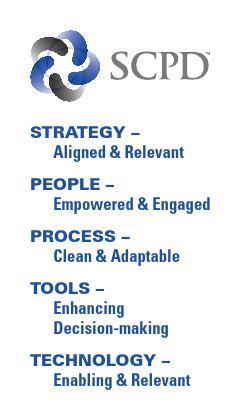

The theme of the 2016 SCPD conference was innovating at the speed of teams. Futurist Cecily Sommers keynoted and closed the session, providing great continuity to the other thought leaders and panelists. (You’ll find the full agenda here and here)
I came away from the conference energized to help firms take on value creation with new insights, methods and tools. Having taken pages of notes, I’ll explore five highlights you can apply today.
The Society of Concurrent Product Development Conference (SCPD) is an educational organization that focuses on building leaders who can innovate big solutions for a healthy future. Having spoken at the 2014 SCPD conference, and attended and blogged about the 2015 session, I was looking forward to what was on the front burner for 2016. The great news, was that they had a full house with rich content at the 3M Innovation Center in Minneapolis, MN.
5 Takeaways From the SCPD Conference
# 1. Breaking our addiction to certainty
Cecily Sommers challenged us to think differently about the creative work we all need to do by reminding us that as humans, we are deeply wedded to our patterns and worldviews. She showed a great old movie clip from Philco that showed that they clearly understood exactly where the future was headed (down to e-banking and shopping), yet, because it seemed so distant, they did not commit the resources to get out and lead it.
Action Point: Just knowing is not enough. We need to do the work to integrate our head knowledge with the engaged work of looking at deep human needs, scenarios of success, prototypes, pilots and trials to wrestle and map concepts to the real world. What can you do to build a “good enough” prototype to get feedback? (for example, the first jet aircraft was inferior to the propeller plane, but paved the way to the future)
#2. Using a story as the tool to build, refine and release your innovative thinking
Jean Storlie led a hands-on workshop in story development for our group. She walked us through the six archetypes of stories, and some very effective prompts that had us all working on great new content.
The SCPD application for this, is that to move a group forward, we need to remember that it’s heart connections that truly pull us together, and there is no more powerful way to create those connections than with well-crafted story.
Action Point: How might you use the power of story to engage your co-workers and leaders in the journey? It’s easy to forget ideas, but hard to forget emotional connections. A great example of story driving culture is the Apple Macintosh teams usage of the pirate flag to create identity and aura around what they were doing.
#3. IOT – Driving the fundamental review of core tenants of business models
We had a powerful panel on the Internet of Things (IOT). Marc, Scott, James and Jennifer spanned B2C, B2B and business applications and did a great job of setting context for IOT. Beyond the tech, which was eye popping, was a powerful underlying meme – the real juice is in the job to be done. Jennifer showed by very practical example how the competitive bicycling world has been transformed via QUARQ, providing a new level of training and fan experience for triathletes.
Action Point: It’s clear IOT is a big deal across all the spaces, but what’s unclear is which vertical markets will be the big winners. Retail firms are all in, services firms are deploying new models, and Uber is eating the world. The key action is to work with someone who has an objective view and review the business model and value chain maps around your space for disruption potential. An idea for a starting point – make sure all your product teams have engaged each other in an IOT dialogue.
#4. The most powerful change is driven by authentic peer narrative
Alex Murphy of Blue Cross Blue Shield walked us through an amazing journey of the homepage for his firm, which he helped take from complete overwhelm to award-winning usability. As you might imagine, the page with the overwhelm was driven by internal product management clamoring to all be on the page, with usability and context taking a back seat.
The stunning part about this journey is that the tool of choice for the transformation was the cross-functional team. With a tool he called “authentic co-authorship,” team members were given “the pen” and full partnership and accountability in the development process. This transparency and line of sight to their peers made the journey perhaps a bit more circuitous, but was transformative in its outcome – both in the website, but perhaps more interestingly, in the ongoing cross-functional cooperation.
Action Point: It takes real skill to create a trusted reciprocal relationship. Where can you employ authentic co-authorship in your work to build amazing outcomes? Where does your firm have silos when it should have bridges?
#5. Deep Empathy Leads to Deep Insights
Aaron Keller of Capsule Design has a new book coming out next month called The Physics of Brand, and from the talk he gave, I would put it on your reading list. By highlighting deep empathy in example after example of his agency’s work, he helped us understand the unspoken language that every interaction has with a product or service. Aaron related a killer case study regarding the organic packaging that he did for Patagonia that highlighted the opportunity to find breakthroughs in unexpected places.
Action Point: Take a field trip and observe your product or service at the point of use. What non-verbal language does the client use when they have the experience, and how might you improve it?
And there was so much more. I would encourage you to look in on the SCPD LinkedIn group to pick up on other memes and themes. If you haven’t put a conference or two on your agenda to refill your mental stores of great approaches to challenges, I would encourage you to find one in your area – you’ll be glad you did.
If accelerating growth from idea to the P&L has been challenging in your firm, it would be great to talk about how the Right Project, Right Team, Right Plan framework might help. You can reach me via email, or give me a call at 847-651-1014 (direct).
Related posts you can benefit from…

